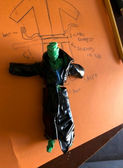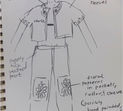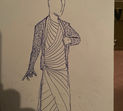The Born Project: Photography Outfits
Throughout the history of traditional western dress, there has been a continual gendering of what is put on the body. The goal within Born was to provide freedom from the constraints of those traditions by inviting participants to design an outfit which they felt best represented who they are. One challenge with this came to light early in the process: as any creative will tell you, a blank page is one of the scariest things in the world.
To help encourage the generation of ideas the creative team decided to provide the participants with a few basic sewing patterns. The simplicity of a basic jumpsuit pattern was chosen as the primary template to work from due to its versatility and inherent neutrality regarding gender. Additional patterns were provided for further inspiration, consisting of a few skirt and pant variations that could be used to customize the looks. Examples showing possible alterations to the patterns were provided as further inspiration. Using these basic templates, the participants could think about different ways to take clothes apart or combine them in a way that served their individual needs.

The ideas generated by the participants were then brought into conversation with myself as the textile designer, who would also ultimately end up making all of the constructed garments. The goals of each individual’s design were discussed along with fit, textures, colors, and the practical considerations of building the custom garments. The nature of many of the outfits meant that the sewing patterns used in the basic templates needed to be altered. This resulted in over a dozen customized sewing patterns for the project, many of which went through multiple iterations in an attempt to keep to the original design vision.
Once initial versions of the garments were patterned and built, participants met the textile designer for individual fittings. At these fittings, participants were able to try on the mockups and have them further customized for fit and design. Other existing garments that were being used in the outfits were also customized and altered. From the fittings, the final versions of the garments were created. Participants were also encouraged to incorporate other pieces of their existing clothing and accessories into the outfit.
The final outcome you see today is the result of hundreds of man-hours of work, not just in the creation of the individual garments, but also in the organization and realization that went into the photo shoot, exhibit, and project as a whole. While we are unfortunately constrained in some of our clothing dreams by the physical limitations of the world we live in, this project serves as a step towards a world where those limitations are not also placed on our individual authenticity.





































































